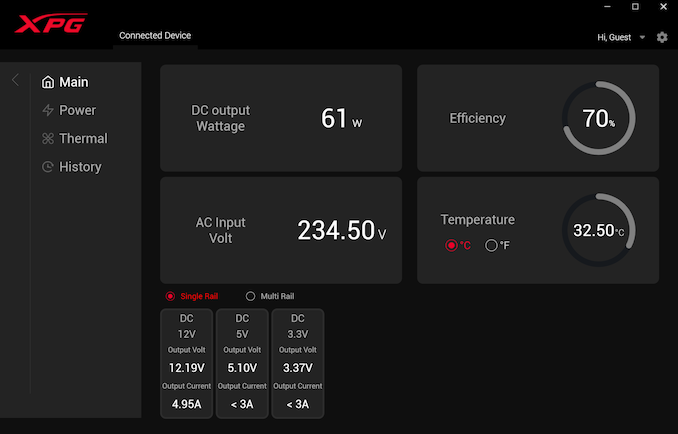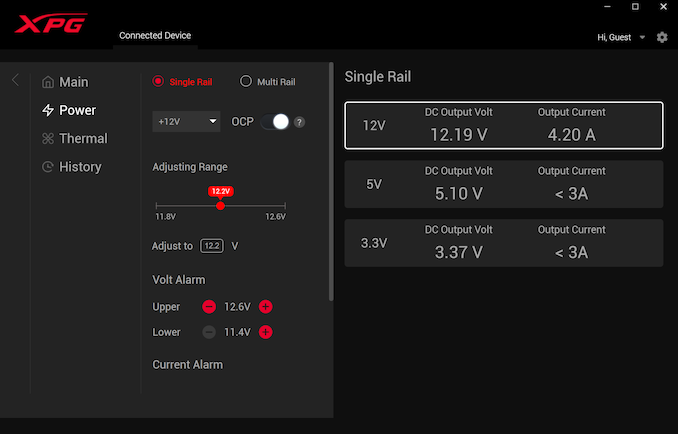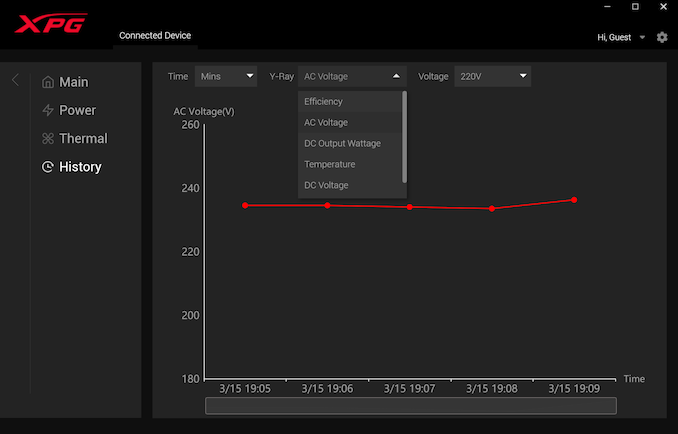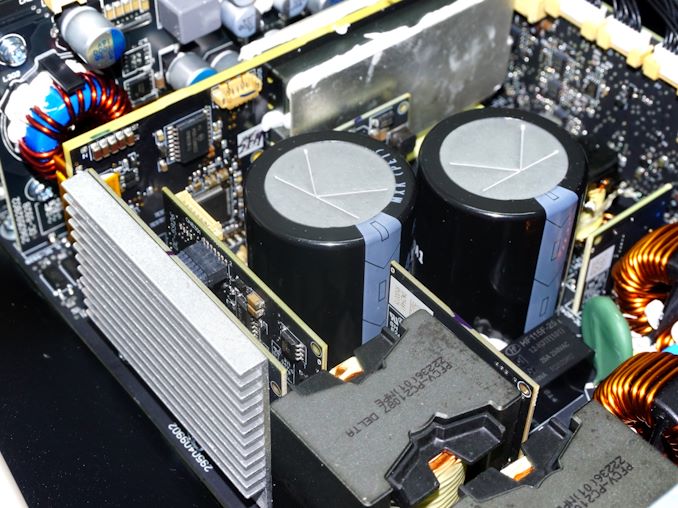The XPG Fusion Titanium 1600 PSU Review: Outrageous Power, Outstanding Quality
by E. Fylladitakis on March 30, 2023 8:00 AM ESTPower Supply Quality, Software & Conclusion
Power Supply Quality
The electrical performance of the XPG Fusion Titanium 1600 PSU is nothing short of stellar. The filtering is amazing, with the ripple hardly reaching 20 mV while the unit outputs 1600 Watts – a mere sixth of the recommended design limit, regardless of the monstrous power output. Regulation is outstanding, at 0.5% on the primary 12V line and 0.9% on the secondary 3.3V/5V lines. By default, the average output voltage for all lines is a little high but there is a reason for that, as we will see in the software section of our review.
| Main Output | ||||||||
| Load (Watts) | 326.4 W | 815.27 W | 1217.99 W | 1621.29 W | ||||
| Load (Percent) | 20.4% | 50.95% | 76.12% | 101.33% | ||||
| Amperes | Volts | Amperes | Volts | Amperes | Volts | Amperes | Volts | |
| 3.3 V | 1.9 | 3.36 | 4.75 | 3.35 | 7.13 | 3.33 | 9.51 | 3.32 |
| 5 V | 1.9 | 5.12 | 4.75 | 5.1 | 7.13 | 5.09 | 9.51 | 5.08 |
| 12 V | 25.35 | 12.24 | 63.38 | 12.23 | 95.07 | 12.18 | 126.76 | 12.16 |
| Line | Regulation (20% to 100% load) |
Voltage Ripple (mV) | |||||
| 20% Load | 50% Load | 75% Load | 100% Load | CL1 12V |
CL2 3.3V + 5V |
||
| 3.3V | 0.9% | 8 | 8 | 12 | 12 | 10 | 12 |
| 5V | 0.9% | 8 | 8 | 14 | 12 | 12 | 14 |
| 12V | 0.6% | 16 | 12 | 14 | 20 | 14 | 12 |
As part of our standard testing, we test the primary protections of all PSUs we review (Over Current, Over Voltage, Over Power, and Short Circuit). All of the protections of the XPG Fusion Titanium function normally. The OCP protection is a bit more complex, as the unit is by default programmed not to allow more than 50A per 12V virtual rail but up to 133.3A total. This is to protect single cables and connectors, as drawing 130A from a single cable would be ruinous. Trying to draw more than 52-53A from a single connector will instantly trigger an OCP shutdown. With the single-rail 12V mode, the OCP protection is a bit slack, as we reached about 120% output on the 12V rail before the OCP immediately triggered a shutdown.
Software
The XPG Fusion Titanium is one of the very few PSUs with a USB interface, allowing monitoring and customization via software. XPG integrated the Fusion Titanium within their Prime software package, which is used to control all compatible XPG devices (mainly keyboards and mice).
Once fired up, the XPG Prime will display some basic input and output electrical figures, such as the input voltage and output wattage. The input wattage does not appear but can be calculated by dividing the output wattage by the efficiency (i.e. 61 W / 0.7 = 87.1 W in this example). These readings are not terribly accurate but they are reasonably close to the actual figures.
From the Power tab, users have limited control over the output voltages and OCP protection limits. By default, the output voltages are set to 12.2V, 5.1V, and 3.4V. Users can adjust the output voltage slightly but the range is so small that will not have any practical consequence on typical PCs. OCP figures can only be adjusted downwards, i.e. users cannot set OCP limits above the maximum ratings.
The Thermal tab allows users to choose one out of three cooling profiles, or even program their own. By default, the thermal profile unit is set to “performance” mode. Switching to “silent” mode will keep the fan disabled up to a load of 600 Watts. Users can program their own cooling profiles and even disable active cooling completely if they want to - in any case, the unit’s OTP protection will ignore the cooling profile if the temperatures get out of hand.
Finally, the History tab is a record of the unit’s basic electrical and thermal figures. Users can choose the sampling rate from minutes to days. “Days” is far too slow a sampling rate for electrical figures. Even “Minutes” is not useful for anything else than indicative records, as a rate of one record per minute cannot be used for any form of accurate measurements, let alone diagnostics. For the latter, the sampling rate would need to be at least in the milliseconds range.
Conclusion
The XPG Fusion Titanium 1600 PSU undoubtedly is an exceptional product that lives up to the company’s extravagant marketing claims. It boasts excellent build quality, top-of-the-line components, and a clean design. Its OEM/ODM, Delta Electronics, is a renowned power electronics manufacturer that is known for producing top-quality products. XPG backs the unit up with a 12-year manufacturer warranty, which should be enough to dissolve any doubts regarding the quality level of the PSU.
The power supply's outstanding power quality is one of its key strengths, with great voltage filtering and very tight voltage regulation on every voltage rail. Filtering is astoundingly good for a unit with that high a power output. The electrical conversion efficiency is very high but not higher than expected for a unit that meets the 80Plus Titanium certification requirements. The unit also exhibits extreme resistance to thermal stress, operating unfazed regardless of the ambient temperature (within reasonable limits).
While noise figures depend on the selected/programmed cooling profile, the XPG Fusion Titanium can typically operate silently with loads up to 500-600 Watts. However, if pressed to operate at loads above 1200 Watts for prolonged periods, it will inevitably produce high levels of noise. Typical gaming PCs and workstations cannot maintain such a high continuous power draw but rendering stations and mining rigs will.
Overall, the XPG Fusion Titanium power supply is a halo product that is typically targeted towards hardcore enthusiasts and users who demand the very best, regardless of the price tag. And with an MSRP of $750, it definitely will be a very expensive product when it's released in May. However, for users who require extreme performance and reliability, this power supply is a solid investment that is worth every penny.
















17 Comments
View All Comments
Techie2 - Thursday, March 30, 2023 - link
It's unfortunate that it is so long as it prevents use in many if not most PC cases.TheinsanegamerN - Monday, April 3, 2023 - link
What century are you from? "most" cases LMFAO. Most PC cases today are gigantic and can easily handle a PSU like this.hubick - Thursday, March 30, 2023 - link
Woulda been nice to see a comparison against my older Corsair AX1600i. I'll keep this one in mind for my next build.E.Fyll - Thursday, March 30, 2023 - link
I intentionally avoided that because the AX1600i is not ATX 3.0 compliant. A basic comparison can be done though by cross-checking the two reviews.https://www.anandtech.com/show/12645/the-corsair-a...
emike09 - Thursday, March 30, 2023 - link
Mining is back with Kaspa, so big PSUs are still a nice thing to have for those that mine. Outside of mining, having PSUs over 1Kw are also becoming a necessity. New Sapphire Lake-X CPUs are power monsters, The RTX 4080 and 4090 are monsters.I have an overclocked i9-10920X and RTX 4090, as well as a few NVMe drives, a several 10TB HDDs, and a bunch of fans, and I hit over 1200w during both gaming and creative workloads. My EVGA 1000w PSU is a beast though, and my KiloWatt meter sometimes shows a draw up to around 1250w from the wall during the heaviest draws without ever hitting OCP.
Makes me want a PSU rated for around 1300-1600w.
Threska - Thursday, March 30, 2023 - link
Soon people will be tripping breakers.pistonsmatter - Tuesday, April 4, 2023 - link
You're only allowed to pull 1,440 watts from a 120V 15a breaker over any period of time, so this PSU is not safe to run on a 15A outlet which is what >99% of people will have available to them in the USA.DigitalFreak - Saturday, April 1, 2023 - link
The sooner governments start making cryptocurrency unprofitable the better.PeachNCream - Tuesday, April 4, 2023 - link
I am reluctant to encourage government intervention, but in the case of cryptocurrencies I agree. They're used by criminals to hide transactions and gullible people tag along for a variety of poorly thought out reasons, enriching criminal enterprises and equipment sellers scamming delusional miners.pistonsmatter - Tuesday, April 4, 2023 - link
Keep in mind you cannot pull more than 1,440 watts from a 15a breaker in the USA or it will eventually trip, don't forget things like your monitor use as much as 200 watts in some cases.